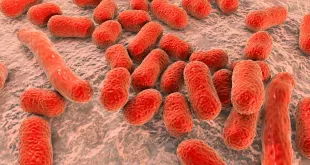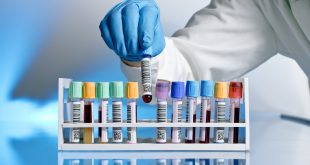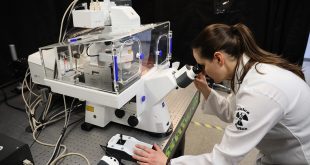By Hermione Wilson
Scientists race to study whether bacteria are a viable solution in the event of an oil spill in the Arctic
It’s a win-win for companies who save millions with shorter shipping routes and cut down on their C02 emissions, says Casey Hubert, University of Calgary professor and microbiologist. But this increase in shipping traffic comes with a different cost. It increases the risk of oil spills in an environment where the consequences of such a disaster are not well understood.
Hubert is one of the principal investigators for GENICE, a new initiative from Genome Canada that is looking to study natural bioremediation. That is the process by which microorganisms that are naturally present in sea water, usually bacteria, consume petroleum hydrocarbons such as oil and diesel. This natural bioremediation has been observed after spills like the blow-out of the Deepwater Horizon in the Gulf of Mexico in 2010.
Currently, there are a number of ways used to clean up an oil spill, one of which is in-situ burning. This method involves igniting the oil so that it burns off of the surface of the water. Because oil is less dense than water, it naturally moves to the surface, which makes skimmers another effective way to clean up spills. Skimmers are a type of mechanical equipment used to physically remove oil from the surface of the water. A third cleanup method is the use of chemical agents such as dispersants, which help to break up an oil slick into small droplets that are then diluted throughout the water.
What happened after the Gulf of Mexico spill in 2010, however, is that a lot of the oil was eliminated from the water due to bacterial degradation, rather than by any other method used to get rid of the oil, says Gary Stern, University of Manitoba professor and chemist. “The oil disappeared more quickly from the environment than they thought it would and studies have shown that it was actually natural bacteria that were present in the environment that degraded the oil,” he says.
Natural Bioremediation
Studies about whether such petroleum hydrocarbon consuming bacteria are present in Arctic waters and if they would function in the same way are few and far between, Stern says. “It’s just difficult to do real field studies nowadays because nobody wants you to be dumping oil into their natural habitat, so it’s very difficult to do those kinds of studies,” he says. Stern points to a few field studies that took place in the 1970s and 1980s, and a few smaller outdoor studies and lab studies over the years, but says that none have been on the scale GENICE is planning.
“Microbes are capable of using hydrocarbons for food, so if they’re in the Arctic environment and if there is a spill, we’re interested in what role they might play in helping with the cleanup effort,” Hubert says. The great thing about these oil-consuming bacteria is that, if they are indeed present in the Arctic waters, they would need little human intervention to do their work. That is especially important in an environment like the Arctic where the resources needed for an oil spill cleanup are often hard to access. “If [these microbes] are present in enough numbers or distributed in the right kind of biogeography or have the right kind of potential to kick it into gear if there was a spill, they might not need a lot of help from us,” Hubert says.
The GENICE project brings together two teams; one from the University of Calgary, led by Hubert, and the other from the University of Manitoba, led by Stern. The team will be working out of the yet-to-be-built Churchill Marine Observatory (CMO) in Churchill, MB. The facilities will include two large concrete pools, 30 by 30 feet wide and 12 feet deep, which will contain seawater pumped in from Hudson Bay. One will serve as the control and the other will have oil added to it. The presence of real seawater, combined with the cold climate of Churchill, will allow the GENICE researchers to study real seawater chemistry with real nutrient loads.
“We add the seawater to the pool, we let it start freezing, and we can actually control the thermodynamics of the ice,” Stern says. “It’s a covered facility, so we can put the cover on or retract the cover, we can heat the water to try and keep it at a certain depth or a thermodynamic state.” The work of GENICE at CMO will allow researchers to observe oil-consuming bacteria at work and eventually provide proof to end users (namely the Coast Guard who are the first responders in the event of an Arctic oil spill) that this method of bioremediation really works.
“We think these bacteria might be nature’s first responders in an emergency, and so it’s important that we understand what they can do without our help,” Hubert says.
There may also be ways to give the bacteria a boost, he says. When cleaning up oil spills on land, fertilizer is often added to the soil to aid bacteria in consuming the oil. It’s possible that adding fertilizer or some other nutrient to seawater at the scene of a spill may have the same function, but the problem is that these nutrients may become diluted or disperse too quickly to be effective.
“There might be a natural level of those fertilizer compounds in seawater anyways, it just might be too low,” Hubert says. “If you consider the oil to nutrient ratio, by using dispersants and smaller droplets of oil, that means that the relative amount of nutrients goes up, and so without adding nutrients you’ve effectively increased the local concentration of those nutrients.” This might be a way of intervening in order to help the bacteria metabolize the oil more quickly, he says.
The Time is Now
Scientists are eager to understand more about cleaning up oil spills in the Arctic now, more than ever. Because of low oil prices and the dangers associated with doing Arctic exploration, a lot of oil companies such as Shell and Exxon have suspended drilling in places like the Beaufort Sea. Exploration will restart again in another decade or so, Stern predicts, so scientists want to take advantage of this time to get the scientific evidence in place that will back up a streamlined response in the event of an Arctic oil spill.
“If we’ve got 10 or 15 years before they start up, we want to make sure that we have some of these methodologies in place so that if there is ever a spill associated with that, then we know how to clean it up,” he says. If the GENICE research team is able to prove that natural bioremediation is the most effective method of cleaning up an oil spill in the Arctic, ships could possibly be required to carry quantities of nutrients with them in case of a spill, Stern says. There would be scientific evidence that the bacteria was present in the water and what per cent of the oil the bacteria could degrade.
Right now, the GENICE researchers are working from the Amundsen Canadian Coast Guard icebreaker ship. The CMO facility is still being constructed and should be up and running by December 2018. “GENICE is just a small part of what we’re going to be doing [at the Churchill Marine Observatory],” Stern says. Studies will also be done into how oil interacts with ice and with the water below the ice, which will allow scientists to track the movement of oil in Arctic waters using remote sensing. The research team will also be looking at the in-situ burning method of oil spill cleanup to learn how the residue of that process interacts with the sediment and biota at the bottom of the ocean once those particles sink.
“We’re looking at all aspects of the ecology, chemistry, genomics and biology and everything that goes on in the Arctic marine system should a spill occur,” Stern says.
 BioLab Business Magazine Together, we reach farther into the Canadian Science community
BioLab Business Magazine Together, we reach farther into the Canadian Science community





